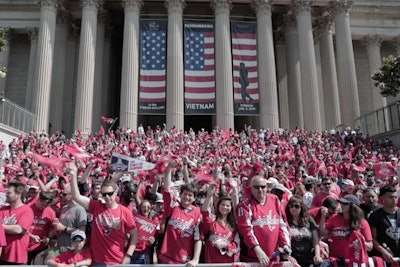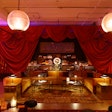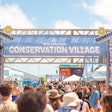
There’s a sports superstition that no one should speak of a celebration before the team has actually won. So the event production agency Hargrove did not hear from the Stanley Cup-winning Washington Capitals about organizing a victory parade for the hockey team until the day of the final game. Planning did not begin until the players had their hands on the trophy, leaving a five-day window to pull everything together for the June 12 event.
Lisa Miller, director of national accounts events at Hargrove, shared how the company navigated the high-pressure, quick-turnaround planning process. The entire team, including staff and players’ families, participated in the three-hour victory parade and program, and fans in a sea of red gathered to celebrate with them.
Make the decision.
With four days to plan a parade attended by hundreds of thousands of people, time is sacred.
“There’s not a lot of time to rethink and rework,” Miller said. “You just have to go with your gut and make the decision. Everything is determined by the route, so it’s the number-one thing. You have to pull the trigger on the route really fast since everything is predicated on it.”
By midday on Friday, they chose a route that ran along Constitution Avenue NW and culminated with a rally at the National Mall. Hargrove then began to obtain the permits needed from the city and park services.
Multitask and distribute the work.
Given the timeframe for planning, Miller said staff worked on many projects at the same time throughout the four days. The production of the stage, logistics for the 47 parade vehicles, speaker order, and reaching out to parade participants—including longtime season ticket holders, elected officials, and other notable figures—were all pursued simultaneously so that the event could be put together as fast as possible.
“We were pushing a bunch of nodes at the same time,” Miller said. “Even the day of the parade is tough work. I had to be there super early and ended up getting a crazy sunburn—I hadn’t put on sunscreen since it was still dark outside when I first got there. But in the end, the hard work falls away and I just feel honored personally to be a part of it.”
Collaborate with experts.
Although Hargrove had a team of 50 dedicated to the parade, the event required many more hands on deck. It sought out partners who have previously worked with Hargrove or the Capitals, such as the audiovisual company EventsBum by Empress, which worked on the stage and screen.
“We had great vendors who we work with all the time, and with just a phone call they jumped right in,” Miller said. “It was a really big group effort and the product of the teamwork of different entities in the city coming together.”
Teams who have won a championship before can use past celebrations as a model, but in this case, this was the team’s first Stanley Cup win.
Go simple with the decor.
Instead of stressing out about the production and the decor, Miller advised to focus on making the event as special as possible for those who are celebrating and those who are being celebrated.
“The branding was about the Capitals being champions—it was focused on the players,” Miller said. “It wasn’t this major build-out of the stage.”
The Hargrove team kept with the Capitals’ red for the color scheme, and chose banners that came up and down easily. The actual Stanley Cup, North America’s oldest professional sports trophy, acted as the centerpiece of the event. The National Mall also became a part of the visuals.
“With the Capitol in the background and the Washington Monument on the other side—how could you go wrong with those visuals?” Miller said. “It’s unbeatable.”
















